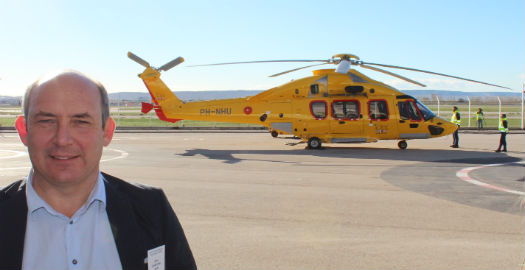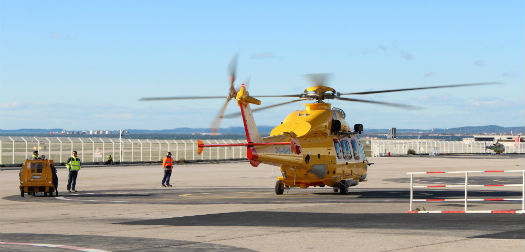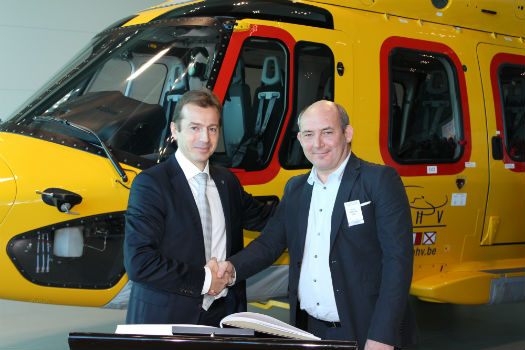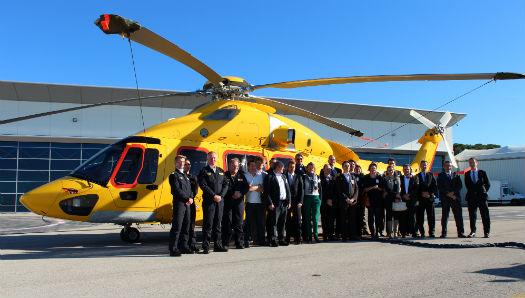
NHV CEO Eric Van Hal said that the oil-and-gas operator is well-prepared for the EC175’s entry into service.
Belgium-based Noordzee Helicopters Vlaanderen (NHV) is putting two new Airbus Helicopters EC175s into commercial service this week. The offshore oil-and-gas helicopter support provider received the first two EC175s as part of a 16-aircraft order on Dec. 11 at the Airbus Helicopters facility in Marignane, France. The EC175 features Pratt & Whitney Canada’s PT6-C67E turboshaft engines and the manufacturer’s proprietary avionics system, Helionix.
The EC175 program has been delayed nearly two years, causing NHV to reshuffle some assets in order to cover the resulting operational gap. As one of three launch customers for the EC175 — the others are UTair in Russia and France’s Heli-Union — NHV maximized the extra time by conducting pilot and maintenance training to familiarize the NHV team with the helicopter, according to CEO Eric Van Hal, who noted it always takes longer to be among the first operators of any type.
“Waiting has its advantages,” Van Hal told Vertical during the delivery ceremony in Marignane, adding that NHV is “well-prepared for the start of operations.” The new helicopters are scheduled to conduct their first commercial flight less than a week after delivery, with pilot and maintenance courses completed prior to the handover.

NHV’s Airbus Helicopters EC175 taxis before a flight to its new base to begin service this week.
Current plans call for Airbus Helicopters to deliver six more EC175s to NHV during 2015, with two at the end of the first quarter, two in September and two at the end of the year. Another EC175 duo will enter service in early 2016, with the rest in 2017, according to Van Hal. The target is to fly between 500 and 600 hours during first quarter 2015, he said.
Part of the program holdup is related to a different aircraft program, the AS332 and EC225 Super Puma, which experienced two ditchings in the North Sea in 2012, leading to a redesign of the main vertical bevel gear shaft. Airbus Helicopters CEO Guillaume Faury said the EC225 problems — which demanded the attention of company engineers following the 2012 incidents — represented a “wake up call” for Airbus Helicopters. “The difficulties served as a driver for us to move forward,” he added.
The manufacturer put together a “transformation plan,” with a focus on increasing quality, safety and reliability across all platforms, in order to “place the bar at a higher level,” he said. Faury pointed to new flight crew operating manual (FCOM) being developed with operators for the EC225, saying that a similar manual will be assembled for the EC175. He also cited the Vision 1000 flight data recorder, which is being installed on all civil variants by the end of 2015, as another step toward ensuring safe operations.
As one of the EC175 launch customers, Van Hal said that NHV had “a lot of meetings with Airbus Helicopters at all sorts of levels, as well as on maintenance systems, data gathering and sharing, training — all sorts of things.” The process continues, “because we are the people who are going to fly the first data on the line, so we are in very close cooperation to ensure the helicopter’s success. The changes will come when we start flying it,” he said. Van Hal envisions “the maturation of the aircraft going very fast” as other operators gather performance data.
Van Hal is pleased with the new helicopter’s performance. “I think they are spot on,” he said. “They took the time to do it right, and certainly after the EC225 problems, they cannot afford to miss this one. They’ve done everything to make it a successful machine.”

Airbus Helicopters CEO Guillaume Faury (left) and NHV CEO Eric Van Hal sign the official handover of the first two EC175s on Dec. 11.
According to Benoit Bagourd, program manager for the NHV EC175 contract at the Marignane plant, it currently takes around 14 months to produce an EC175, mainly because it’s a new program. With production ramping up, the manufacturer seeks to reduce that time to about six months. The aircraft has more than 12,000 parts, not including standard parts such as rivets. Currently, 18 helicopters are in various stages of production at the EC175 plan in Marignane.
Nicolas Jaunard, marketing manager for Airbus Helicopters Training Services, noted that instruction for NHV maintenance personnel began in April 2014, with NHV pilots starting simulator training in July. Through early December, a total of 14 NHV pilots have gone through the training program. The syllabus includes eight hours in the flight navigation procedures trainer (FNPT), followed by 13 hours in a Level D-qualified full flight simulator (FFS) developed in partnership with Indra Systems, and concludes with five hours of flight training in the EC175.
According to Faury, there are currently 64 orders for the EC175, with about two-thirds of those considered firm. The helicopter is intended for oil-and-gas markets, as well as search-and-rescue, passenger transport and corporate/VIP operators. The manufacturer is also working on a version with de-icing certification.

Teams from NHV and Airbus Helicopters gather around an EC175 during the ceremony for the first two deliveries of the type.
In early 2014, Airbus Helicopters reached a framework agreement with Avicopter to create a 50/50 organization that will jointly produce the EC175 and its Chinese counterpart, the AC352, which features Turbomeca/Avic Ardiden 3C engines. The partnership to produce 1,000 helicopters is valued at around US$19.3 billion.
“Ten years from now, China will be a very important market, if not the most important one, in terms of sales of new helicopters,” said Faury. “But for the moment, it remains rather limited.” He added that the agreement allows for Airbus Helicopters to cover a number of countries in Europe, North America and South America with the EC175, while Avicopter is in charge of commercializing the AC352 variant inside and around China.









